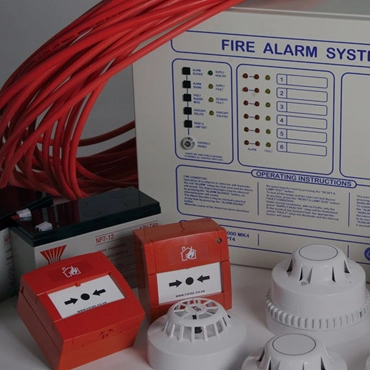Wireless fire alarms are an integral part of modern fire safety systems, offering flexibility, ease of installation, and efficient performance in detecting and alerting people to fires.
Below, we delve into how wireless fire alarms work, their components, advantages, and considerations for their implementation. To get your wireless fire alarm installed, contact our team at ARC Fire Safety & Security Ltd for more information!
Understanding Wireless Radio Fire Alarms
At its core, a wireless fire alarm system functions similarly to wired but without the need for physical cables connecting the alarm devices. These systems use radio frequencies (RF) to communicate between sensors, detectors, control panels, and alarm devices. The primary components include smoke detectors, heat detectors, manual call points, control panels, and signalling devices.
Radio fire alarm solutions are designed to function on the specifically regulated and compliant 868 MHz frequency, ensuring reliable and secure communication. This particular frequency band is regulated by Ofcom and is exclusively allocated for critical safety systems such as radio fire alarms and radio intruder alarms.
These systems are not susceptible to interference from other radio frequencies, which could compromise their operation. For instance, common sources of radio interference, such as taxi cabs using their communication equipment while parked outside, cannot disrupt the signal of these alarms. This is crucial in maintaining the integrity and reliability of the alarm system, providing peace of mind that the system will perform as expected in emergencies.
Despite concerns that may arise due to experiences with unreliable WiFi, it's important to understand that the technology and frequency band used for radio fire alarm solutions are entirely different and far more robust. The distinct nature of the 868 MHz frequency ensures that the alarm system's performance is not affected by the typical issues that can cause WiFi to drop out, thereby offering a dependable solution for site safety.
Key Components and Their Functions
Smoke and heat detectors are placed at strategic locations throughout a building to detect smoke or an unusual temperature rise. Smoke detectors can be photoelectric or ionisation-based, whereas heat detectors may work on a fixed temperature or rate of rise principle. Additionally, manual call points are installed at accessible locations, allowing individuals to manually trigger the alarm in case of a fire.
Next, the control panel acts as the system's brain, receiving signals from detectors and manual call points. It processes these signals to determine the presence of a fire and then activates the alarm devices. Whilst this is happening, signalling devices, including sirens, strobe lights, and voice evacuation messages alert people of the danger and facilitate an evacuation.
How It Works
The process begins with the detection of fire indicators (smoke or heat) by the detectors, which then send a radio signal to the control panel. Then, the signal is transmitted wirelessly, as a wireless fire alarm, using radio waves. The specific frequency used is typically reserved for emergency services to prevent interference. Upon receiving the signal, the control panel evaluates the information to confirm the fire event. It then wirelessly triggers the signalling devices to alert others. Individuals are then alerted through alarms and signals. The system may also integrate with other building management systems for tasks like unlocking doors or shutting down HVAC systems to prevent the spread of smoke.
Advantages
-
Flexibility: Wireless systems can be easily modified or expanded without the need for extensive rewiring.
-
Ease of Installation: They significantly reduce installation time and disruption, making them ideal for historical buildings or operational businesses.
-
Reliability: Wireless fire alarms have become highly reliable. They include battery backup and signal encryption to prevent tampering or interference.
Considerations
-
Maintenance: Regular testing and battery checks are crucial to ensure system reliability.
-
Range and Interference: To prevent signal loss or interference, the system's design must account for the building's size and layout.
-
Cost: Initial costs may be higher than wired systems due to the technology involved. However, the savings in installation and flexibility can offset these costs over time.
We Offer:
-
Approved Installers and service providers
-
Many years of technical experience
-
Full support at design and radio survey stages and ongoing technical support
-
Full Programming and Commissioning undertaken
-
Reduced installation time. Minimal disruption.
-
No unsightly cables or containment
-
Remote buildings linked without trenches or overhead cables
-
Less work for future alterations or additions
Wireless fire alarms represent a significant advancement in fire safety technology, providing an efficient, flexible, and reliable solution for protecting lives and property. Their ease of installation and adaptability make them suitable for a wide range of applications, from residential to commercial buildings. As technology continues to evolve, wireless fire alarm systems are set to become an even more integral part of modern fire safety strategies.
At ARC Fire Safety & Security, we are proud to offer a range of wireless fire alarms across the South. To learn more about what we offer and how we can protect your business or building, contact our team today. We look forward to speaking with you.
